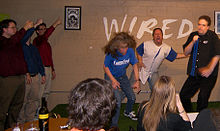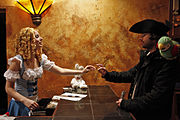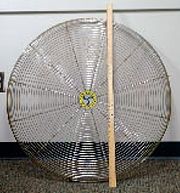- Improvisation
-
 ComedySportz Austin performing a shortform game based on direction from the audience with the help of Red Dirt Improv; in this case spoofing a hard rock band performing a song made up on the stage
ComedySportz Austin performing a shortform game based on direction from the audience with the help of Red Dirt Improv; in this case spoofing a hard rock band performing a song made up on the stage
Improvisation is the practice of acting, singing, talking and reacting, of making and creating, in the moment and in response to the stimulus of one's immediate environment and inner feelings. This can result in the invention of new thought patterns, new practices, new structures or symbols, and/or new ways to act. This invention cycle occurs most effectively when the practitioner has a thorough intuitive and technical understanding of the necessary skills and concerns within the improvised domain. Improvisation can be thought of as an "on the spot" or "off the cuff" spontaneous activity.
The skills of improvisation can apply to many different abilities or forms of communication and expression across all artistic, scientific, physical, cognitive, academic, and non-academic disciplines. For example, improvisation can make a significant contribution in music, dance, cooking, presenting a speech, sales, personal or romantic relationships, sports, flower arranging, martial arts, psychotherapy, and much more. Techniques of improvisation are widely trained in the entertainment arts; for example, music, theatre and dance. To "extemporize" or "ad lib" is basically the same as improvising. Colloquial terms such as "let's play it by the ear," "take it as it comes," and "make it up as we go along" are all used to describe "improvisation."
The simple act of speaking requires a good deal of improvisation because the mind is addressing its own thought and creating its unrehearsed delivery in words, sounds and gestures, forming unpredictable statements that feed back into the thought process (the performer as listener), creating an enriched process that is not unlike instantaneous composition [with a given set or repertoire of elements].[1]
Where the improvisation is intended to solve a problem on a temporary basis, the 'proper' solution being unavailable at the time, it may be known as a stop-gap. This particularly applies to engineering improvisations.
Contents
Music
Improvisation is usually defined as the composition of music while simultaneously singing or playing an instrument. In other words, the art of improvisation can be understood as composing music "on the fly". Improvisation can take place as a solo performance, or interdependently in ensemble with other players. When done well, it often elicits gratifying emotional responses from the audience. One notable improvisational pianist is Franz Liszt. The origins of Liszt's improvisation in an earlier tradition of playing variations on a theme were mastered and epitomized by Johann Sebastian Bach, Wolfgang Amadeus Mozart, and Ludwig van Beethoven.
Other notable improvisational musicians include: Keith Jarrett, an improvisational jazz pianist and multi-instrumentalist who has performed many completely improvised concerts all over the world; Derek Bailey, an improvisational guitarist; and Eugene Friesen, an improvisational cellist.
Improvised freestyle rap is commonly practiced as a part of rappers' creative processes, as a "finished product" for release on recordings (when the improvisation is judged good enough), as a spiritual event, as a means of verbal combat in battle rap, and, simply, for fun. It often incorporates insults similar to those in the African-American game the dozens, and complex rhythmic and sometimes melodic forms comparable to those heard in jazz improvisation.
A few pianists[who?] have given modern recitals of improvisation in the baroque style. An example of an improvisational pianist in the style of baroque improvisation was Glenn Gould. There have also been a few other exceptional improvised solo piano concerts[who?] in Stuttgart, Southern Germany in the 1990s.
In the realm of silent film music, there are also a small number of musicians whose work has been recognized as exceptional by critics, scholars and audiences alike; these include Neil Brand and John Sweeney, among others who are all performers at "Le Giornate del Cinema Muto", the annual conference on silent film in Pordenone, Italy. Their performances must match the style and pacing of those films which they accompany and the knowledge of a wide range of musical styles is required, as well as the stamina to play for films which occasionally run more than three hours in length, without a pause.
Theatre
 The Ligue d'improvisation montréalaise (LIM) is a league of improvisational theater based in Montreal, Quebec, Canada
The Ligue d'improvisation montréalaise (LIM) is a league of improvisational theater based in Montreal, Quebec, Canada
Dance
Dance improvisation as a choreographic tool: Improvisation is used as a choreographic tool in dance composition. Experimenting with the concepts of shape, space, time, and energy while moving without inhibition or cognitive thinking can create unique and innovative movement designs, spatial configuration, dynamics, and unpredictable rhythms. Improvisation without inhibition allows the choreographer to connect to their deepest creative self, which in turn clears the way for pure invention.
Contact improvisation: a form developed in 1973, that is now practiced around the world. Contact improvisation originated from the movement studies of Steve Paxton in the 1970s and developed through the continued exploration of the Judson Dance Theater. It is a dance form based on sharing weight, partnering, playing with weight and unpredictable outcomes.
Comedy
Improvisational comedy is a theater art performed throughout the world and has had on-again, off-again status throughout history.
Some of the more famous improv theaters and training centers in the world include: i.O. (formerly ImprovOlympic) in Chicago and Los Angeles, The Second City in Chicago and Toronto, The Players Workshop in Chicago, National Comedy Theatre in San Diego, New York and Phoenix, Upright Citizens Brigade, The Peoples Improv Theater in New York City, the Groundlings, BATS Improv in San Francisco, Wing-It Productions in Seattle, Philly Improv Theater in Philadelphia], Dudley Riggs BraveNew Workshop in Minneapolis, ComedySportz in Milwaukee, Washington Improv Theater in Washington D.C., and Theatresports in Calgary, Canada.
There are also many well known university improv teams, including Theatre Strike Force at the University of Florida.
Notable pioneers in the field of improvisation, comedic or otherwise, include Viola Spolin, Paul Sills, David Shepherd, Del Close, Josephine Forsberg, Stan Wells, Gary Austin, Martin de Maat, and Keith Johnstone. Notable performers include: Paul Merton, Stephen Colbert, Steve Carell, Bill Murray, Harold Ramis, Robert Townsend, Colin Mochrie, Ryan Stiles, Ross Noble, Wayne Brady, Jonathan Winters, Bill Chott, and Gil Christner.
Poetry
Traditional epic poetry included improvisation moments where the reciter flattered the audience (especially the authorities) or to substitute a forgotten passage. There are also societies that value improvised poetry as a genre, often as a debate or "poetic joust", where improvisators compete for public approval. Some of these impromptu poems are later recorded in paper or transmitted orally.[citation needed]
Some of these forms also include humour. But Michel Ducom established himself within Bordeaux poetical improvisation movement in the 1990s but has since composed and performed with a wide range of poets working in diverse poetical areas (Bernat Manciet, Serge Pey, Méryl Marchetti…). The emergence of poetical improvisation, like previous developments in French poetry, was largely tied to the free jazz experience.[citation needed]
Sculpture
Sculpture often relies on the enlargement of a small model or maquette to create the final work in a chosen material. Where the material is plastic such as clay, a working structure or armature often needs to be built to allow the pre-determined design to be realized. Alan Thornhill's method for working with clay abandons the maquette,[2] seeing it as ultimately deadening to creativity.[3] Without the restrictions of the armature, a clay matrix of elements allows that when recognisable forms start to emerge, they can be essentially disregarded by turning the work, allowing for infinite possibility and the chance for the unforeseen to emerge more powerfully at a later stage.
Moving from adding and taking away to purely reductive working, the architectural considerations of turning the work are eased considerably but continued removal of material through the rejection of forms deemed too obvious can mean one ends up with nothing. Former pupil Jon Edgar uses Thornhill's method as a creative extension to direct carving in stone and wood.
Film
The director Mike Leigh uses lengthy improvisations developed over a period of weeks to build characters and story lines for his films. He starts with some sketch ideas of how he thinks things might develop but does not reveal all his intentions with the cast who discover their fate and act out their responses as their destinies are gradually revealed, including significant aspects of their lives which will not subsequently be shown onscreen. The final filming draws on dialogue and actions that have been recorded during the improvisation period.
The film company ACT 2 CAM uses improvisation to create the characters, contexts and plot for their films. Improvisation also forms a large part of the final filmed product.
Television
Improvisation was originally rarely used on dramatic television. A major exception was the situation comedy Mork and Mindy where star Robin Williams, famed for this kind of performing, was allotted specific sections in each episode where he was allowed to perform freely.
In the 1990s, a TV show called Whose Line Is It Anyway? popularized shortform comedic improvisation; the original version aired on British television, but it was later revived and popularized in the United States, with Drew Carey as its host. With improvisation becoming a more common aspect of television, there have been television shows which have garnered great success by utilizing partial improvisation to create longer-form programs with more dramatic flavor while some shows are completely improvised in terms of lines, including: The Office, Parks and Recreation, Curb Your Enthusiasm, Significant Others, The Loop, Sons & Daughters, 10 Items or Less, Dog Bites Man, Halfway Home, Reno 911!, Free Ride, Campus Ladies, Players, and After Lately.
In Canada, the Global Television soap opera Train 48, based on the Australian series Going Home, uses a form of structured improvisation, in which actors improvise dialog from written plot outlines. Australia's Thank God You're Here is a game show where celebrities are put into scenes they know nothing about and have to improvise.
Engineering
 SAGEM - Mobile myx55 with very strong signs of use that, despite widespread use as a bottle opener, are still functional
SAGEM - Mobile myx55 with very strong signs of use that, despite widespread use as a bottle opener, are still functional
Improvisation in engineering is to solve a problem with the tools and materials immediately at hand. A classic example of such improvisation was the re-engineering of carbon dioxide scrubbers with the materials on hand during the Apollo 13 space mission.
Engineering improvisations may be needed because of emergencies, embargo, obsolescence of a product and the loss of manufacturer support, or perhaps just a lack of funding appropriate for a better solution.
The popular television program MacGyver used as its gimmick a hero who could solve almost any problem with jury rigged devices from everyday materials, a Swiss Army knife and some duct tape.
Improvised weapons
Improvised weapons are often used by guerrillas, insurgents and criminals as conventional weapons may be unavailable. Such weapons vary in sophistication from simple sharpened sticks, to petrol bombs and home made napalm, to IEDs and make shift bomber aircraft.
General references
- Abbot, John. 2009. Improvisation in Rehearsal. Nick Hern Books. ISBN 978-1-85459-523-2
- Abbot, John. 2007. The Improvisation Book. Nick Hern Books. ISBN 978-1-85459-961-2
- Johnston, Chris. 2006. The Improvisation Game: Discovering the Secrets of Spontaneous Performance. Nick Hern Books. ISBN 978-1-85459-668-0
- Nachmanovitch, Stephen. 1990. Free Play: Improvisation in Life and Art. Penguin/Tarcher. ISBN 0-87477-578-7 (cloth); ISBN 0-87477-631-7 (pbk)
References
- ^ (The Speech Chain: The Physics and Biology of Spoken Language (Paperback)," Peter B. Denes (Author), Elliot N. Pinson (Author). 1966. Worth Publishers; Second Edition (February 15, 1993))
- ^ Alan Thornhill on the tradition of pre-conceiving sculpture 1989 studio archive footage, YouTube
- ^ Film: Spirit in Mass – Journey into Sculpture (2007)
External links
Categories:- Music genres
- Theatre
- Dance technique
- Sculpture techniques
- Film techniques
- Poetic devices
- Engineering
Wikimedia Foundation. 2010.

